Must-Have Concrete Tools
Keep all of these tools on hand when working on any slab, foundation wall, patio, or other concrete project for better, faster results.
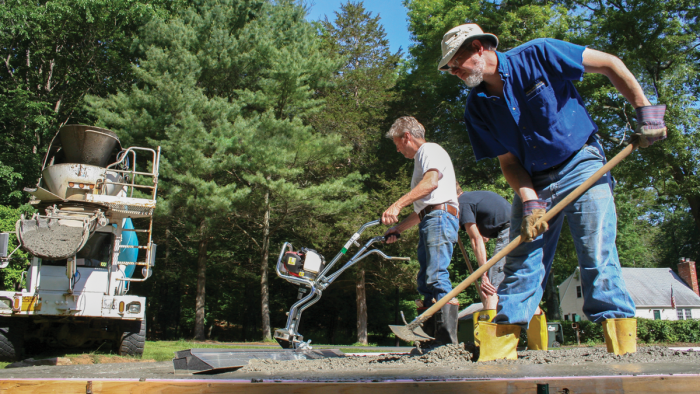
Synopsis: Remodeler Andy Engel lists the best tools to place and finish a concrete slab, from the rebar cutters needed to set up reinforcement, to the discharge truck used to unload the concrete, to the various brooms and trowels used to form a professional finish.
Knowing the tools needed to place and finish a concrete slab is a road map to doing good concrete work. Most of the hand tools are relatively inexpensive, and most of the more expensive ones can be rented. Concrete is pretty safe stuff most of the time, though it can cause chemical burns, particularly with extended contact. Long pants, long-sleeved shirts, rubber overboots, and gloves are called for when working the wet slab. Safety glasses aren’t a bad idea either. When saw-cutting concrete, but sure an electrical saw is plugged into a GFCI outlet and wear safety glasses, hearing protection, and at least an N95 dust mask or respirator because of the silica dust.
It takes surprisingly little water for concrete to complete the chemical reactions that make it hard—so little it would be unworkable without some additional water. To be workable, concrete must be wet enough to flow tight to the forms and for air bubbles to escape. The wetter concrete is, the easier it is to settle into the forms—but the weaker it will ultimately be. That’s because concrete’s strength is related to its density. From a chemical standpoint, any water that isn’t necessary for the reaction just takes up space. When that water eventually evaporates (which can take weeks), it leaves tiny voids that reduce the density and strength of the concrete. Also, if it’s too wet, the water on top of a slab won’t evaporate fast enough to allow tooling before the underlying concrete is too hard to work. Adding plasticizer to the mix costs a little more money, but it temporarily lowers the slump of the concrete without affecting its ultimate strength.
Whether your tools are rented or bought, washing the concrete off before it sets up is crucial. The higher the water pressure in your hose, the easier it is to clean concrete tools. The pressure in the hose on board every concrete truck is Niagara-like. Ask the driver if you can use that water to wash off your tools before the truck leaves.
Set up reinforcement
The first phase of concrete work involves no concrete. Assuming the ground is properly compacted and the gravel below the future slab is level, reinforcement is the first step. Most concrete footings and foundations have some rebar in them, and slabs frequently have rebar or reinforcing wire.
Concrete is very strong in compression, but will crack when placed in tension. Steel rebar adds tensile strength to concrete. Wire mesh keeps the surface of the slab in plane should cracks develop.
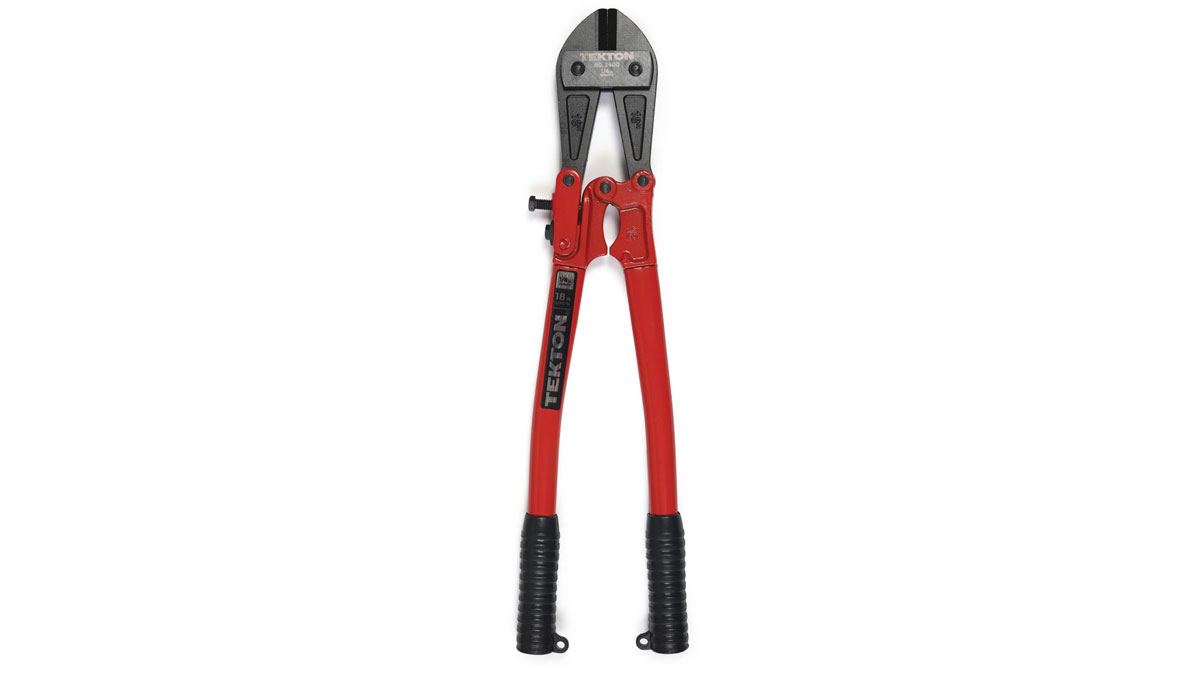
Bolt cutters
Simple tools, bolt cutters’ main purpose in concrete work is to cut welded wire mesh to size. An 18-in. cutter is perfect for this task. You can also use a grinder with an abrasive wheel or a circular saw with a carbide or abrasive blade made for metal-cutting, but the bolt cutters are just as fast and don’t require power or batteries. Be sure to wear a face shield when working with cutoff wheels, which sometimes shatter, throwing partial discs of carborundum and fiberglass at high velocity.
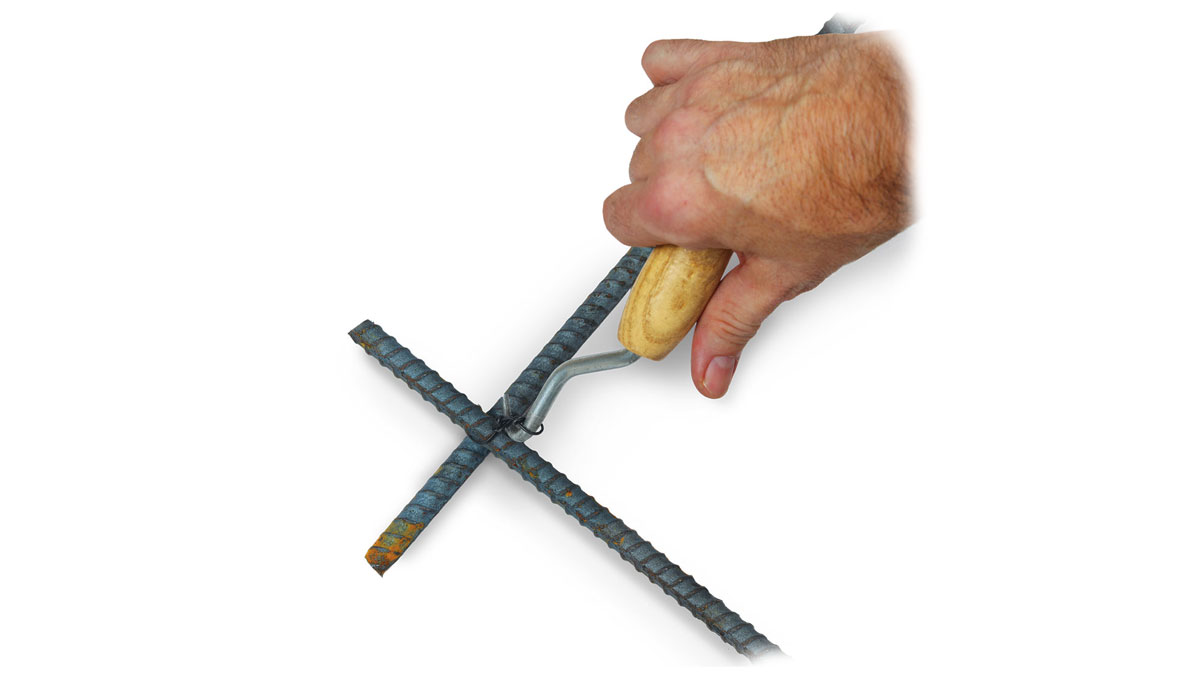
Tie twister
On small jobs, rebar can be wired together with pliers and 14-ga. steel wire. (The standard lap required when joining bars lengthwise is 40 bar diameters—i.e., #4 bar, which measures 1⁄2 in., must overlap at least 20 in.). If you only have a couple of pieces, this is no big deal. For bigger projects, use a tie twister with special rebar wires, which speeds up the tying process dramatically.
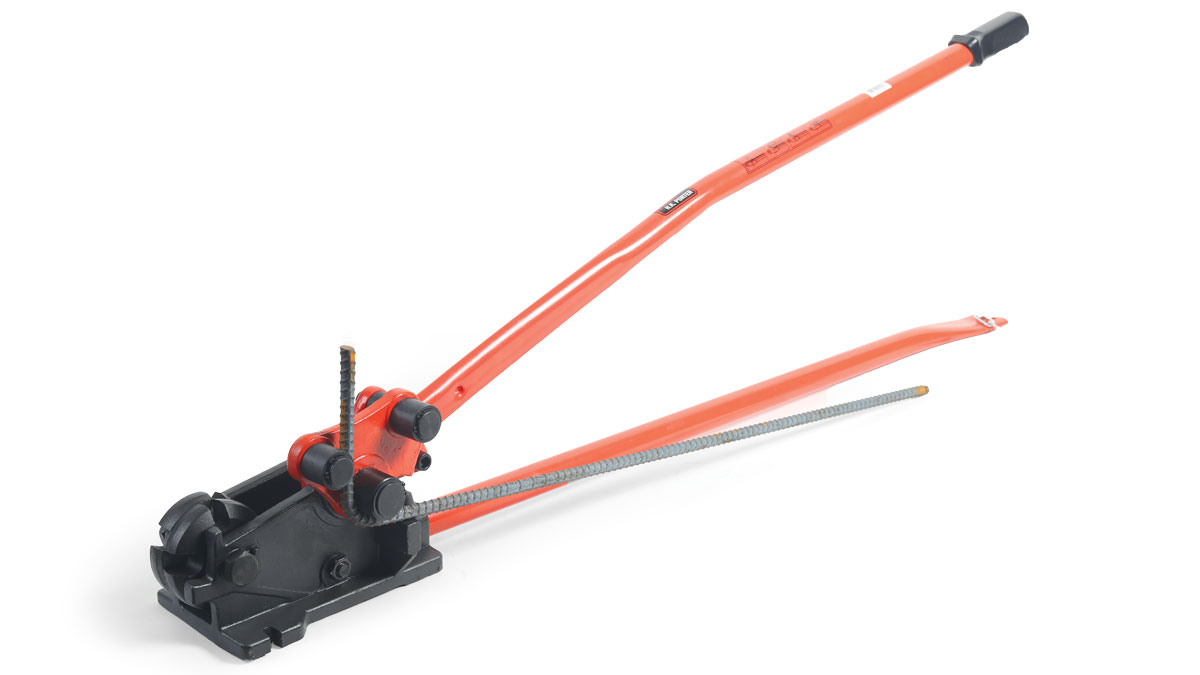
Rebar bender/cutter
Rebar is hard steel—cutting it isn’t something you do with bolt cutters. It is also as hard to bend as it is to cut. For cutting on small jobs, you can get away with an angle grinder. For bending in a pinch, I’ve stuck the end of a piece of rebar in the trailer-ball hole of an F-250’s bumper and used that as a fulcrum, or I’ve improvised a bender out of a pair of steel pipes. The results were serviceable but not great, and mostly limited to #4 bar. A rebar bender/cutter makes for much neater, more easily controlled bends, and cuts rebar much faster than a grinder.
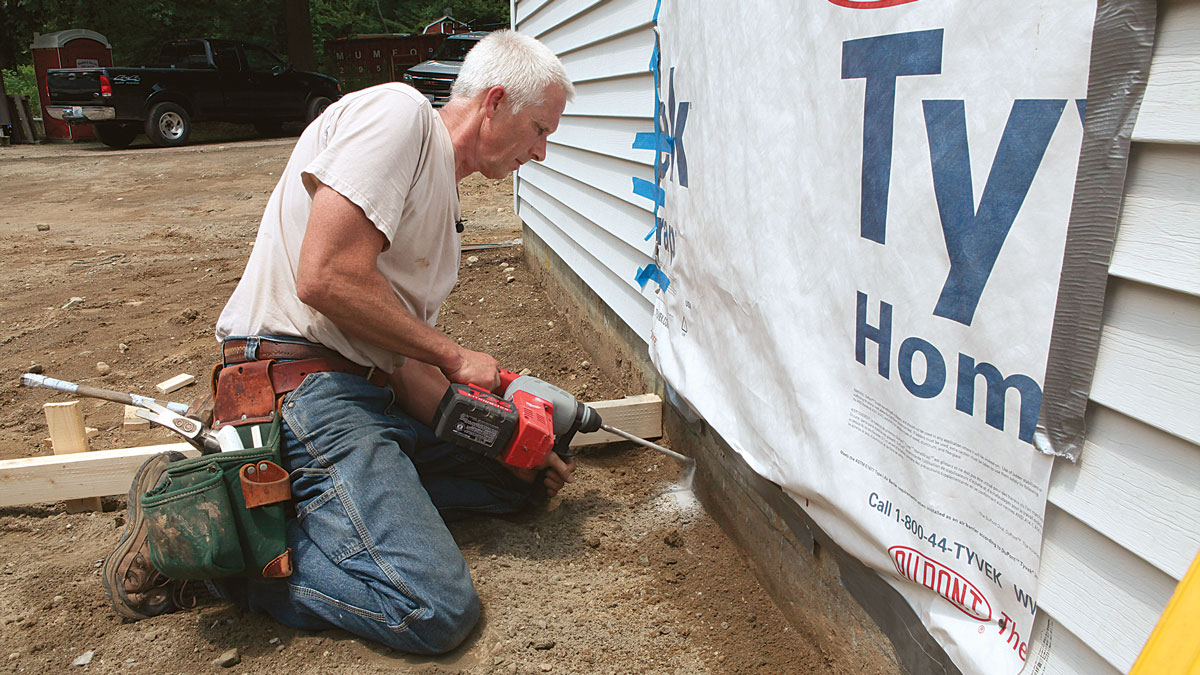
Rotary hammer
It’s common to abut new concrete to existing—for example, when building an addition to a house. The plans should specify a doweled connection, which simply means you drill into the existing concrete so lengths of rebar can be inserted into place. Some circumstances call for the dowel to be epoxied into place, while others require some movement and the engineer will call for the rebar to be greased so the concrete doesn’t adhere. The number, depth, and diameter of the rebar dowels will be specified on the engineering drawings. In any case, the tool to use for drilling the holes is a rotary hammer. Most contractors already own one, but you can rent them too.
Perfect methods of Placement
Concrete is heavy. A standard 10-cu.-yd. truckload weighs 40,000 lb. and is enough for 750 sq. ft. of 4-in.-thick slab, accounting for spillage and assorted variances. You’ll want to move as little concrete by hand as possible while also moving fast. Concrete begins setting up the instant the first water is added, and ready-mix companies only give limited time to unload the truck once on-site.
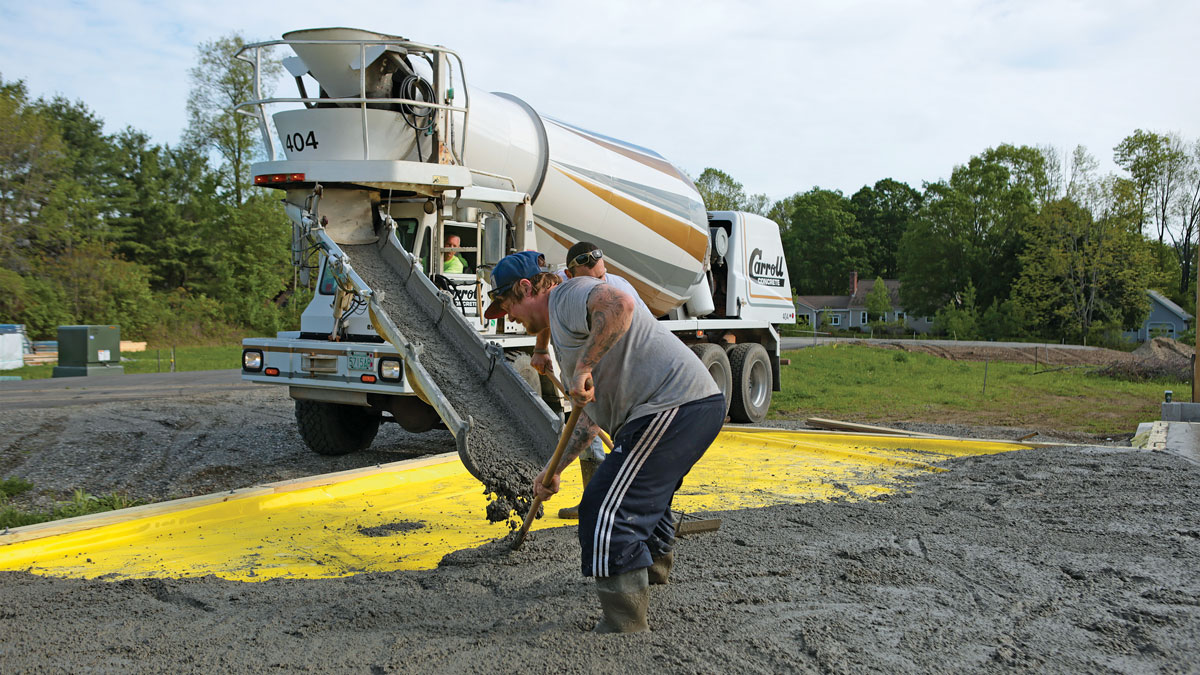
Front-discharge truck
Obviously, the simplest method of placement is to get the ready-mix truck close enough to the hole so that the truck’s own chute can place the concrete. I had an epiphany about this process when I moved from New Jersey to Connecticut 25 years ago. In Jersey, all the trucks had rear-wheel drive and rear discharge. They could get pretty close, but because the driver had no direct line of sight, he could only help you out so much. And because of the rear-wheel-drive configuration, firing up the backhoe to drag a concrete truck out of the mud was a regular event. Connecticut introduced me to front-discharge, all-wheel-drive concrete trucks. I have yet to see one stuck in the mud. And because the driver can see and control the chute from inside the cab, the concrete mostly ends up exactly where you want it. If you can’t get close enough with the truck’s standard chutes, ready-mix suppliers can often send additional chutes for a reasonable upcharge. Longer chutes are at a more shallow angle, so you may have to pull the concrete.
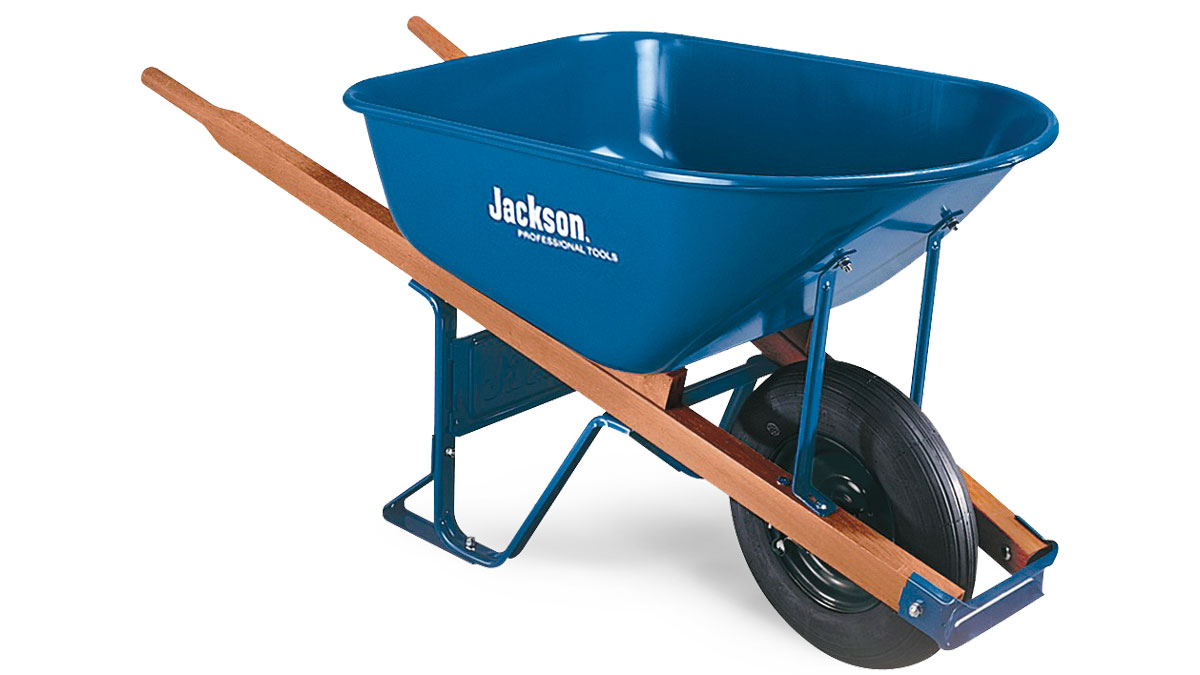
Steel wheelbarrow
Wheelbarrows are an obvious and cheap vessel for moving concrete (or mixing it by hand). Don’t buy a plastic wheelbarrow. They are lighter but flex when loaded, making them very difficult to maneuver around a site. A high-quality steel wheelbarrow is rigid and far easier to push when full of wet concrete. Your concrete wheelbarrow should also have solid tires—few things make me lose my temper, but a flat tire on a wheelbarrow full of concrete is one of them.
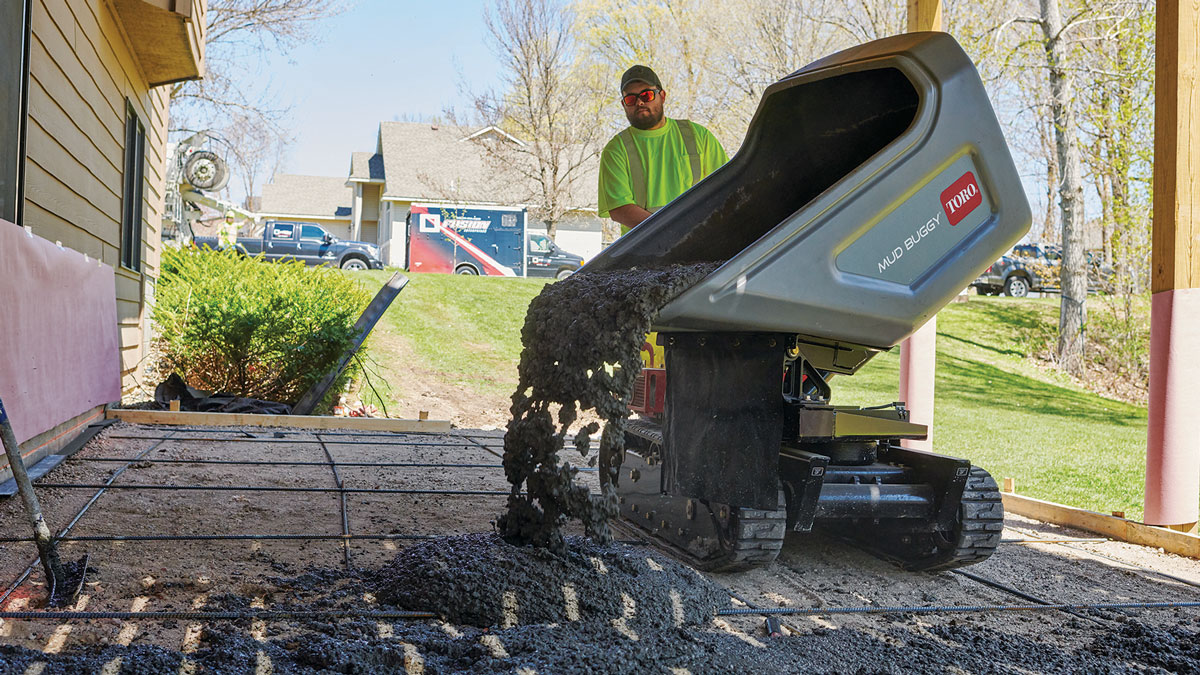
Powered wheelbarrow
Concrete buggies (or “mud buggies”) are big, motorized wheelbarrows. They’re a great way to move concrete from the street to the backyard. If you have more than a couple of yards that need wheeling, consider renting a buggy.
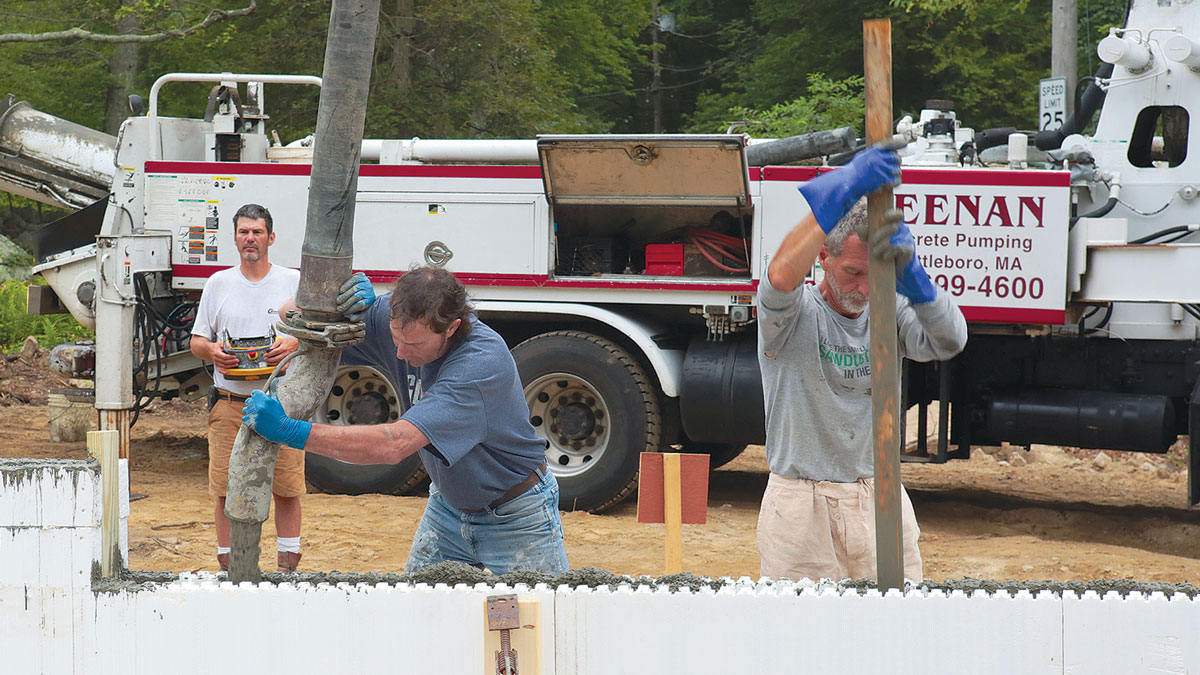
Concrete Pump
An even easier way to move concrete long distances is with a pump. Concrete pumps are specialized trucks or truck-pulled trailers. Concrete from the mixer flows into a hopper on the pump truck, and that truck pumps it to where the concrete is needed. There are two main types of pump truck. Line or grout pumps push the slurry through a 4-in. hose that gets manhandled around the site. Boom trucks have hydraulic-controlled booms so the truck driver can move the concrete hose and outlet to where you need it. Unless you’re experienced, it’s a good idea to hire a crew with a boom truck. Some have mechanical arms with a 100-ft. reach. Neither is cheap, but for large projects where you need to move a lot of concrete quickly or for sites with difficult access, they’re the way to go.
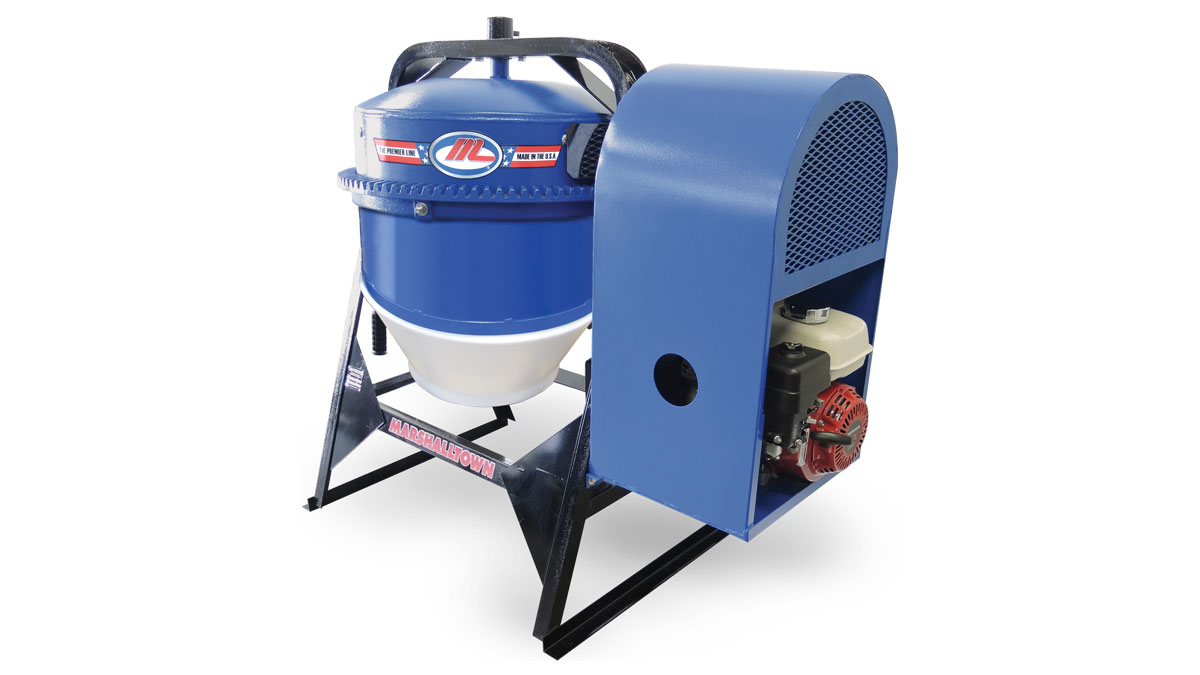
Portable Mixer
Hand-mixing in a wheelbarrow is often fine for small concrete jobs, but a portable mixer is faster and will save your back on bigger projects. Portable mixers are also ideal for larger jobs where there is no ready-mix plant or site access is impossible for a concrete truck. Sizes range from the smallest models found at home centers that sell for a few hundred dollars to large tow-behind machines that can mix nearly 1⁄2 yd. of concrete at a time and sell for thousands. At least two sizes will be available at good rental yards.
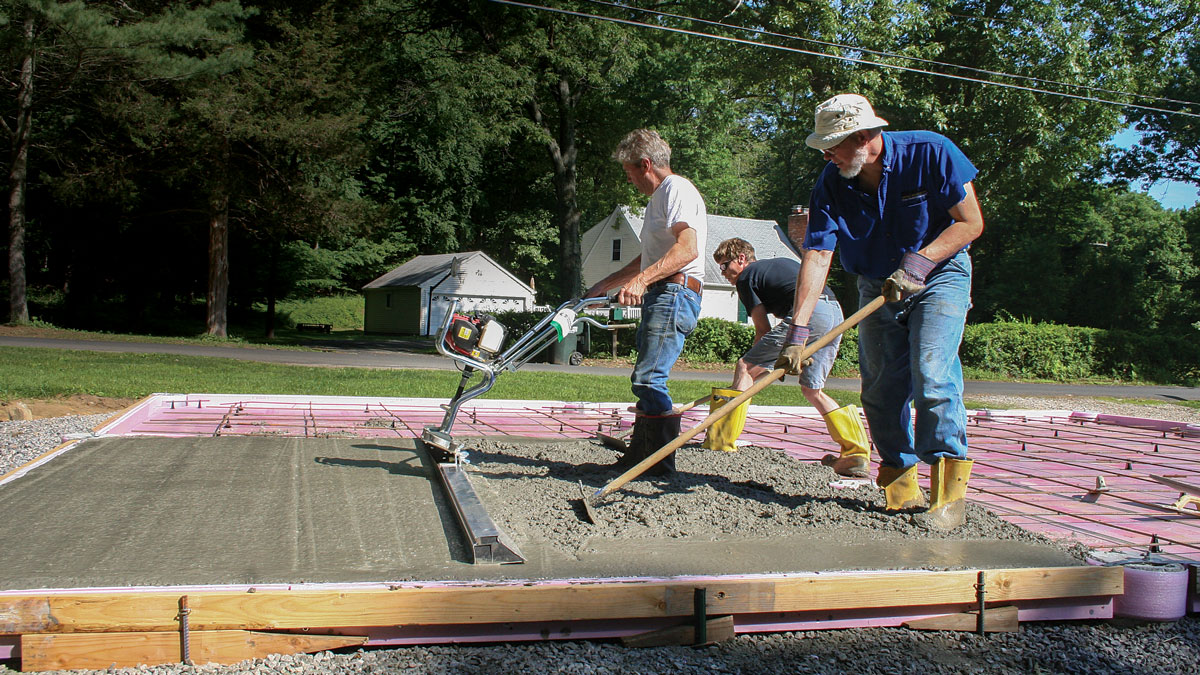
Vibratory screed
I will never do another big slab without renting one of these—ever. Screeding a big slab by sawing back and forth with a 2×4 or metal screed works, but it’s exhausting. Vibratory screeds work by attaching a gasoline-motor-powered vibrator to either its own integral metal screed or to a 2×4. The tool’s vibration settles the concrete while replacing the hard physical labor of screeding. A spinning screed is another type of powered screed that will make the job go smoothly (pun intended). Renting or buying one of these for your next slab is the best tip in this article, hands down.
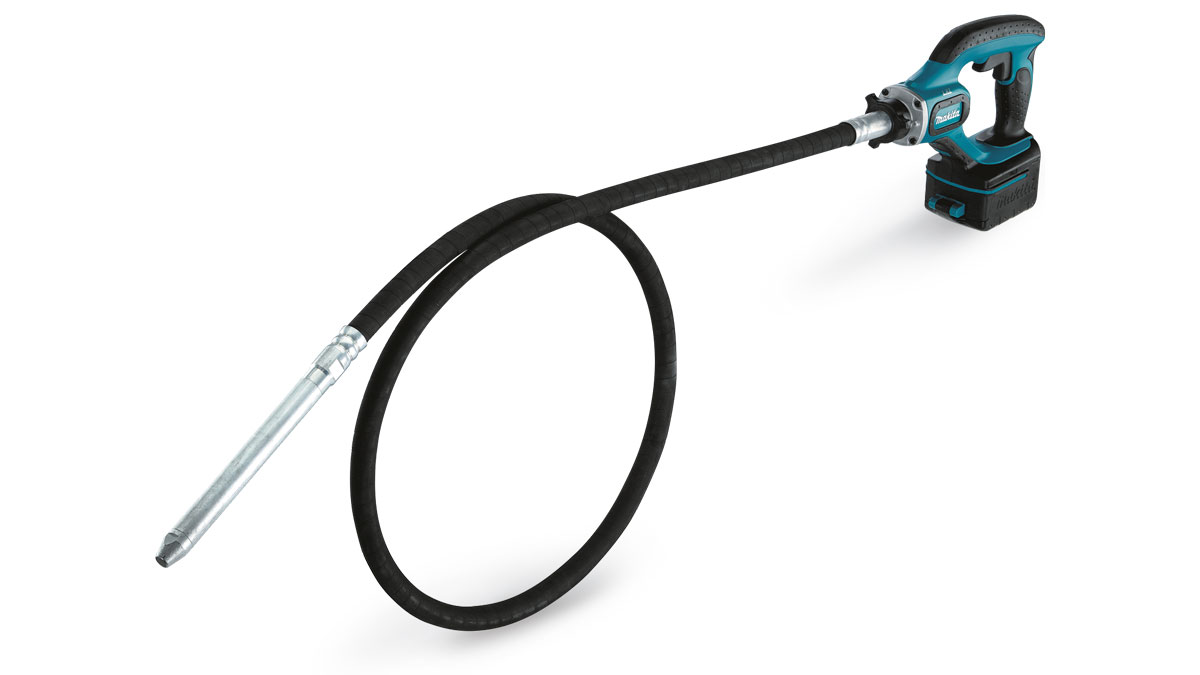
Vibrator
One tool that’s useful with both walls and slabs is the concrete vibrator. A slender metal mechanism powered by a flexible shaft that ties to either an electric or gas motor, concrete vibrators help settle wet concrete into its forms. Every rental yard in existence will have a concrete vibrator. The key is to vibrate sparingly.
Concrete is a mix of Portland cement, water, and large (gravel) and small (sand) aggregate. The sand fills the spaces between the gravel, and a slurry of Portland and water fills the space between both. Vibration helps concrete to flow and fill all the voids around the rebar and forms. With slabs, vibration helps settle the coarse aggregate and makes finishing easier.
Using one takes a delicate touch—excessive vibration can separate the large and small aggregate too much, weakening the concrete. For that reason, don’t hit the rebar or the sides of the forms with the vibrator any more than you can help. If appearance is a concern, you can tap the forms with a hammer or take the blade out of your recip saw and run it up and down the form a little bit. Don’t get carried away, though, because vibration liquefies concrete and the added hydraulic pressure can blow out the forms.
Tip: for small projects, such as concrete countertops or small slabs, a reciprocating saw without the blade can stand in as a concrete vibrator.
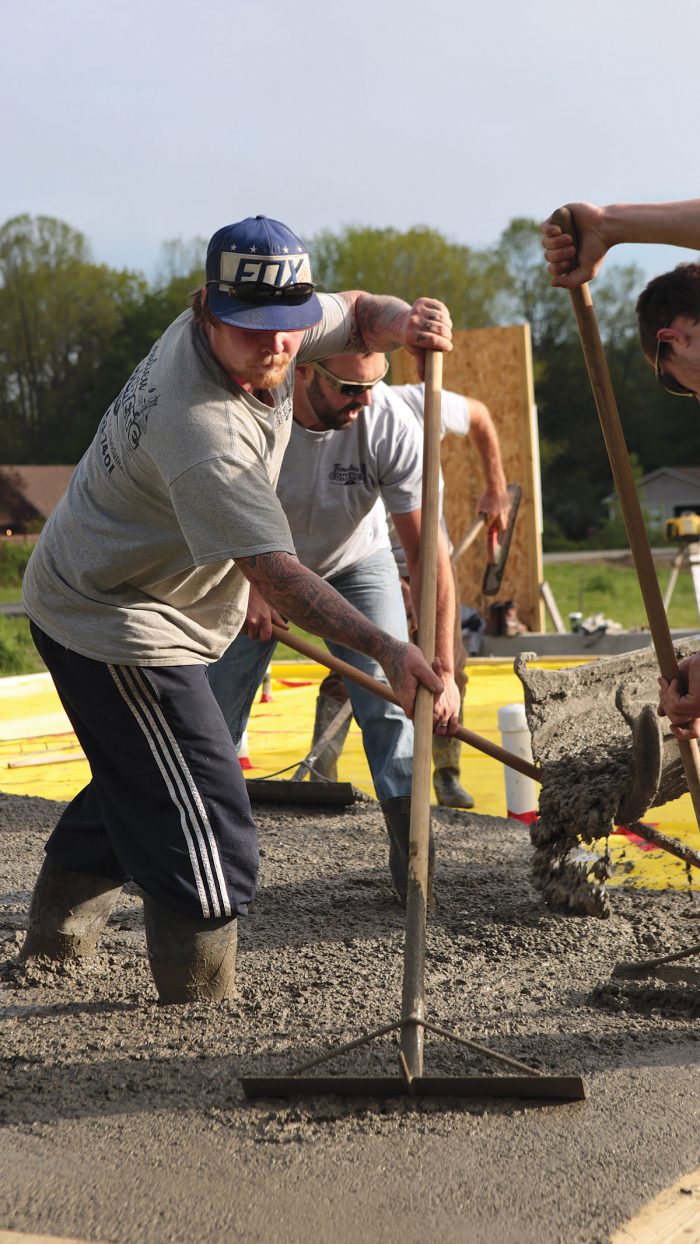
Come-Along
The simplest, most useful tool you aren’t using is the come-along, also called a placer. Essentially a solid rake, the come-along is the perfect tool for pulling and rough-leveling concrete for a slab. Do not use a steel landscape rake to move concrete—this will segregate the aggregate, seriously reducing the strength of the concrete. There is a hook on top of a come-along to pull up reinforcing wire when needed.
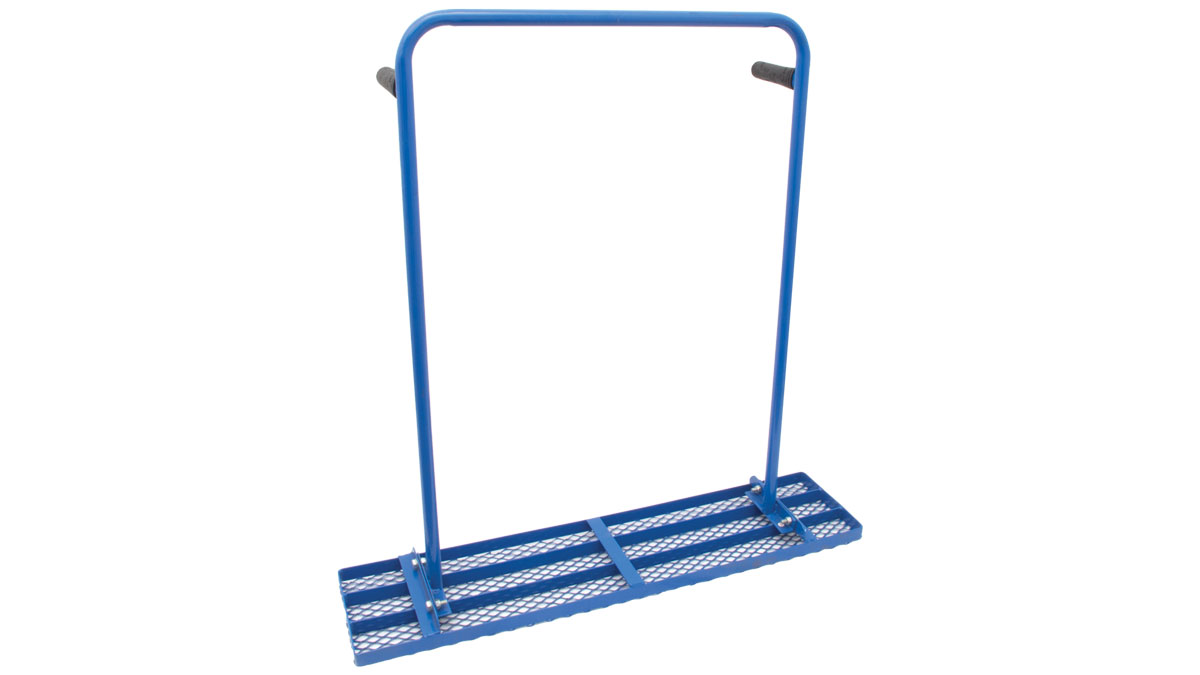
Concrete tamper
Composed of wire mesh in a frame with a pair of handles, a concrete tamper pushes the coarse aggregate down into the surface of a slab to make finishing easier. However, it can settle the aggregate too deeply, increasing the likelihood of freeze-thaw cycles scaling the top of exterior slabs in cold climates. Therefore, tampers should be used judiciously and only on slabs not subject to freezing. Their use should be limited to very stiff (low-slump) concrete or concrete with unusually large aggregate such as 1-1⁄2-in. stone.
What slump?
Slump is determined by filling a special cone with a sample of fully mixed concrete, removing the cone, and measuring how much the wet material sinks (or “slumps”). A 4-in. slump is considered the standard for structural purposes, but without special tools 4 in. is unworkable. Most residential concrete is placed at a 5-in. or 6-in. slump. It’s a balancing act, and the tools you use to settle concrete into its place and to level slabs are crucial to the success of the job. For concrete work such as footings, a shovel and a piece of rebar are most of the tools you’ll need. All that you have to do is move the concrete through the forms, jab the shovel (or in tight places, the rebar) in a few times, and bang on the side of the forms with a hammer to burp out big air bubbles. A mag float does a fine job of tooling the top of the concrete level with the forms.
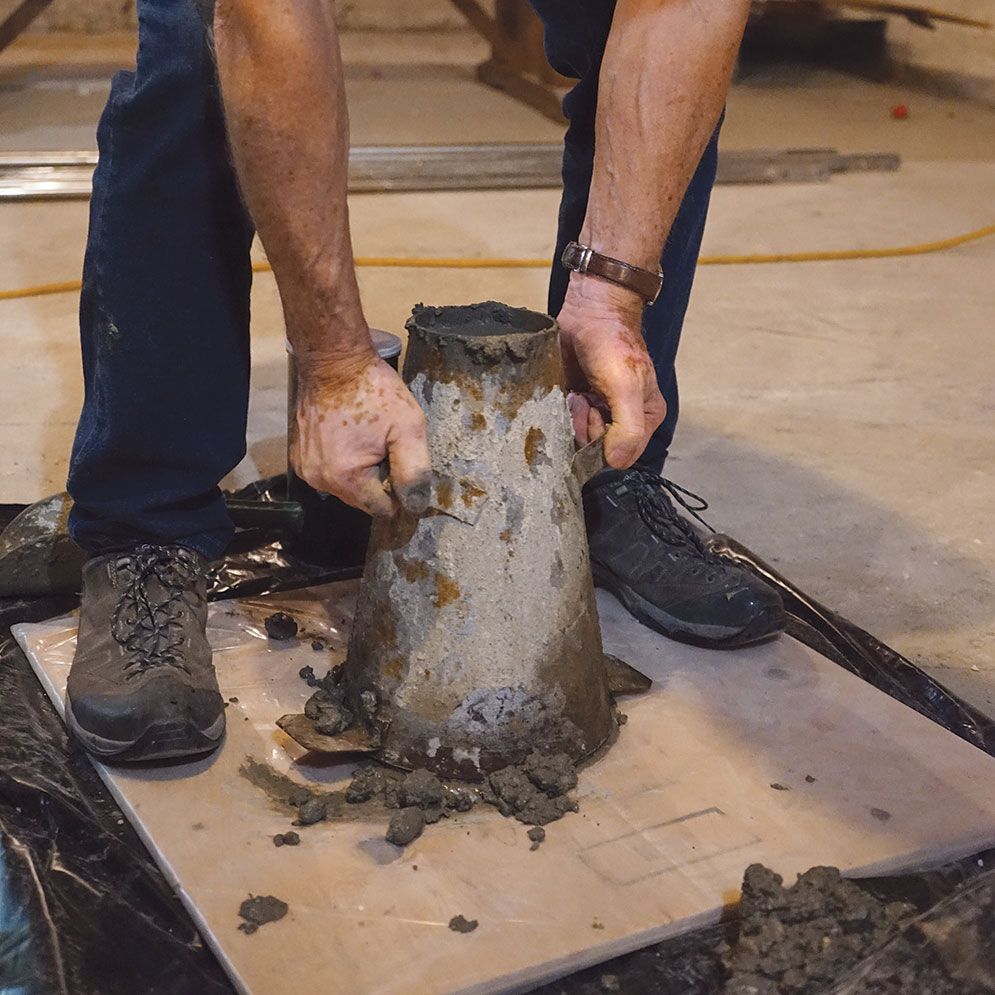 |
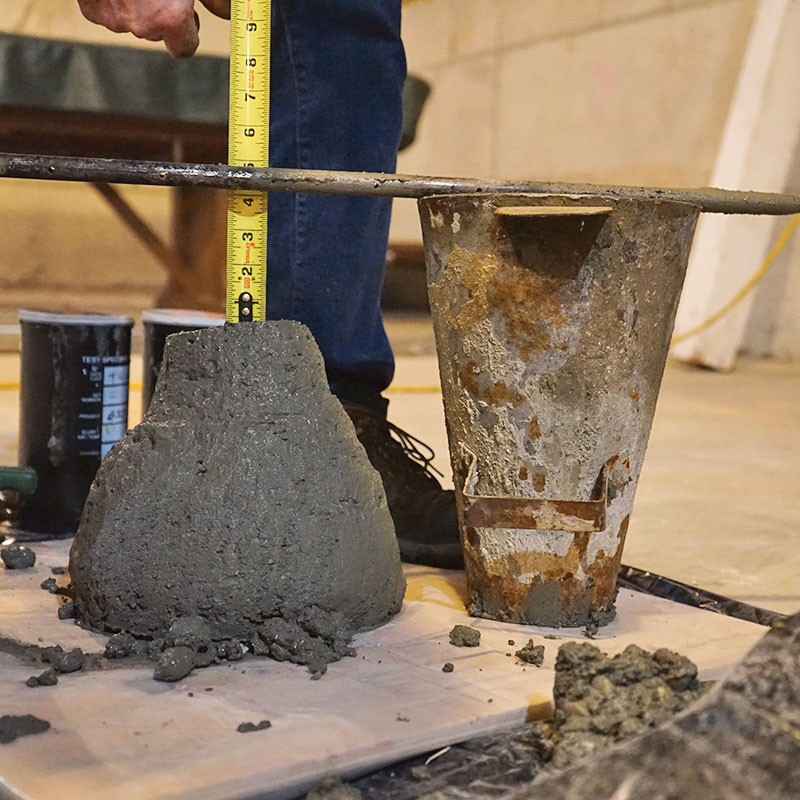 |
Slabs and walls are a different story. There, the fit and finish of the concrete becomes much more important. Most builders, myself included, hire out foundation walls. The forms are heavy and expensive, the work takes experience, and mistakes are costly.
Finishing brings it home
Finishing is when the magic happens and where concrete skills really shine. It’s also the most nerve-wracking time because the window when concrete is workable shrinks rapidly. Concrete finishing is done in a specific sequence, and each of these tools is appropriate only at certain times during the process. Using them incorrectly can affect the finish and durability of a slab.
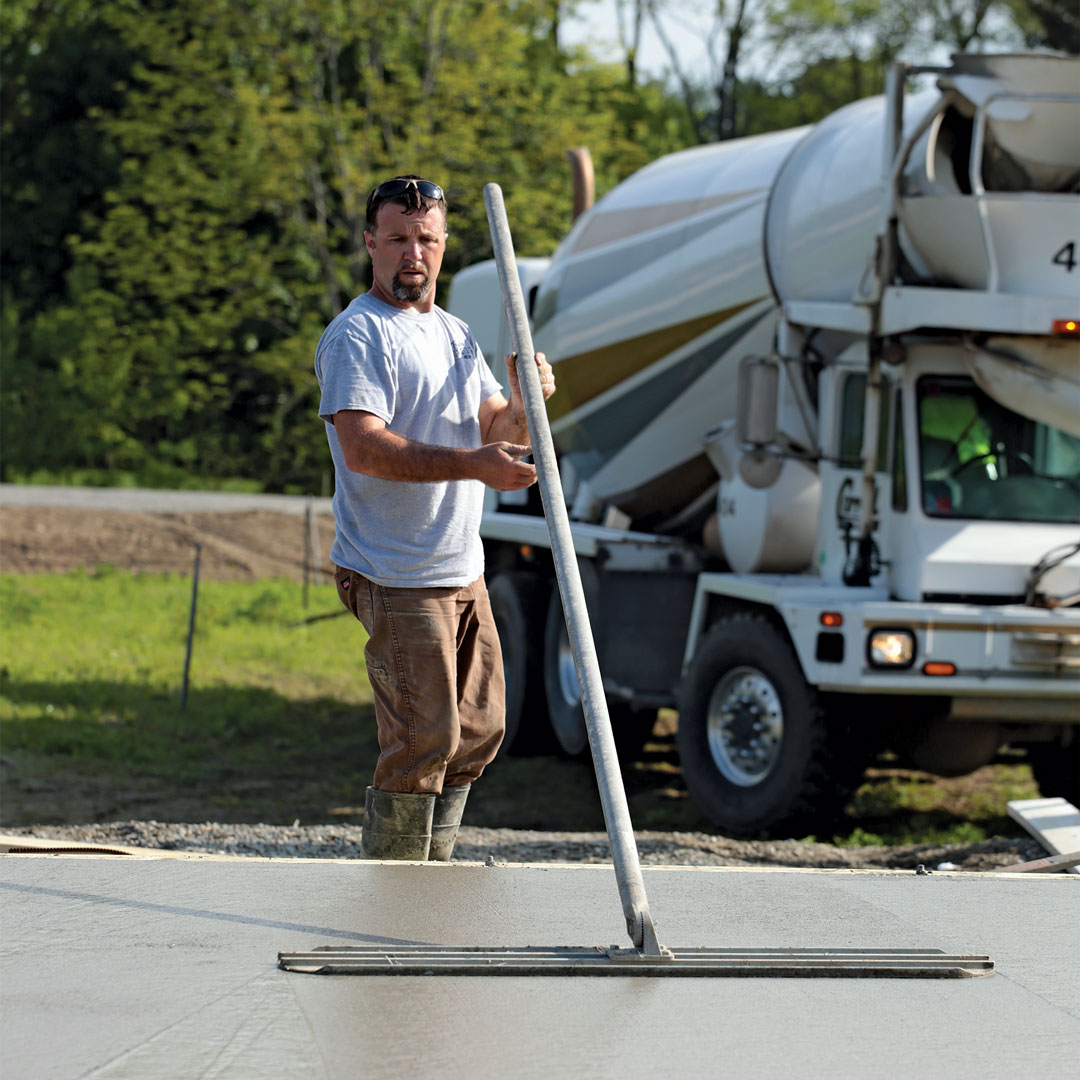
Bull float
Screeding leaves a coarse surface that needs smoothing to be useful. A bull float is the first tool in the sequence and is used immediately after screeding to remove ridges and fill hollows while slightly depressing the coarse aggregate. The aluminum blade of the bull float doesn’t seal the surface of the concrete the way steel does, which is one difference between a bull float and a steel trowel. At this stage, it’s important not to seal the concrete to facilitate evaporation of the excess water.
Bull floats are typically about 8 in. by 48 in. They have sectional handles that assemble to as long as 18 ft., allowing the user to stand outside the concrete while floating. The handle joins the float with a universal joint, so you can twist the handle to change the float’s angle of attack: Lowering the handle raises the front edge of the float slightly, making it easier to push the float away from you; raising the handle does the opposite.
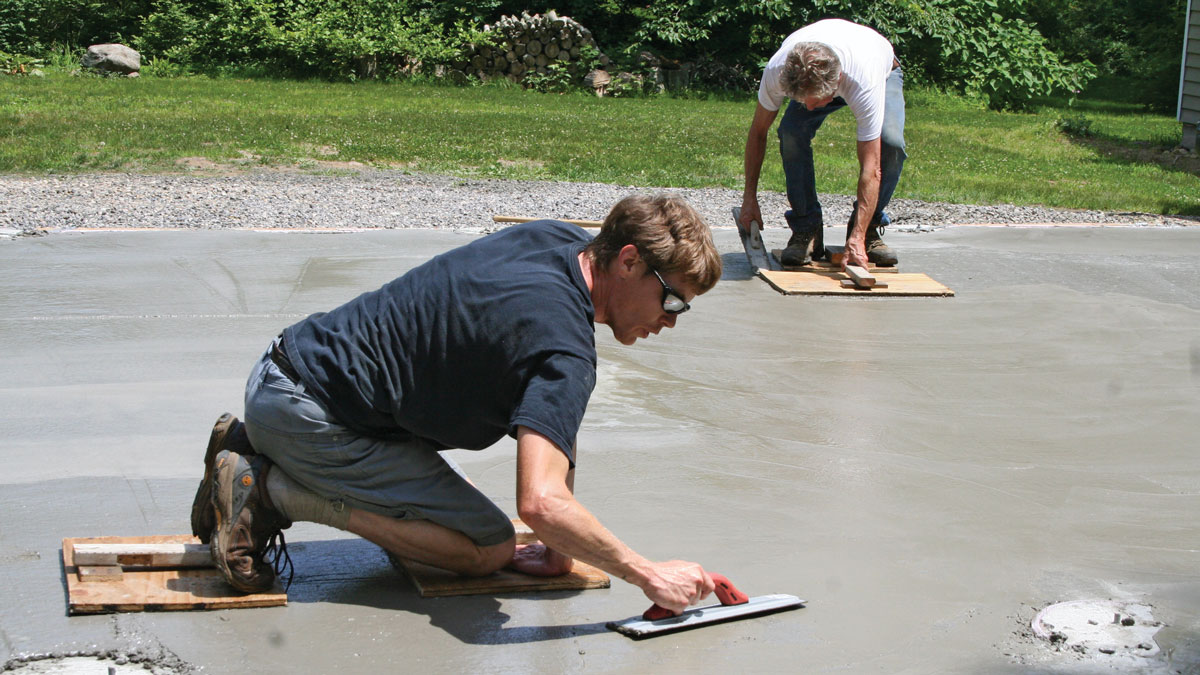
Kneeboards
Once the slab begins to set, you need to get on it to trowel it without leaving deep footprints. Concrete finishers use kneeboards that spread out their weight like snowshoes for this task. You can buy nice aluminum kneeboards with integral kneepads—but while these look plush, they aren’t cheap, and I’ve never seen them used in residential construction. More typical are pieces of 1⁄2-in. plywood about 8 in. wide and 2 ft. long with strips of wood fastened to the front edge to make them easier to pick up.
To use kneeboards, you walk out to the center of the hardening slab and then kneel down on them to float or trowel. Working backward toward the edge of the slab, you smooth out the marks left by the boards—and, inevitably, the toes of your boots—as you go.
Mag float or wood float
Mag is short for magnesium, the metal mag floats are made from. In decades past, wooden floats served the same purpose. Mag floats smooth the lines from the bull float, and on small jobs are often used in place of bull-floating. They’re employed as the bleed water evaporates and the top of the concrete begins to lose its sheen. Mag floats don’t polish the surface, but rather “bring up the cream,” meaning they further help to embed the coarse aggregate below the surface and bring moisture up from below as that on top evaporates. The point is to create a surface that’s open to allow bleed water to evaporate, for further finishing with a steel trowel or concrete broom.
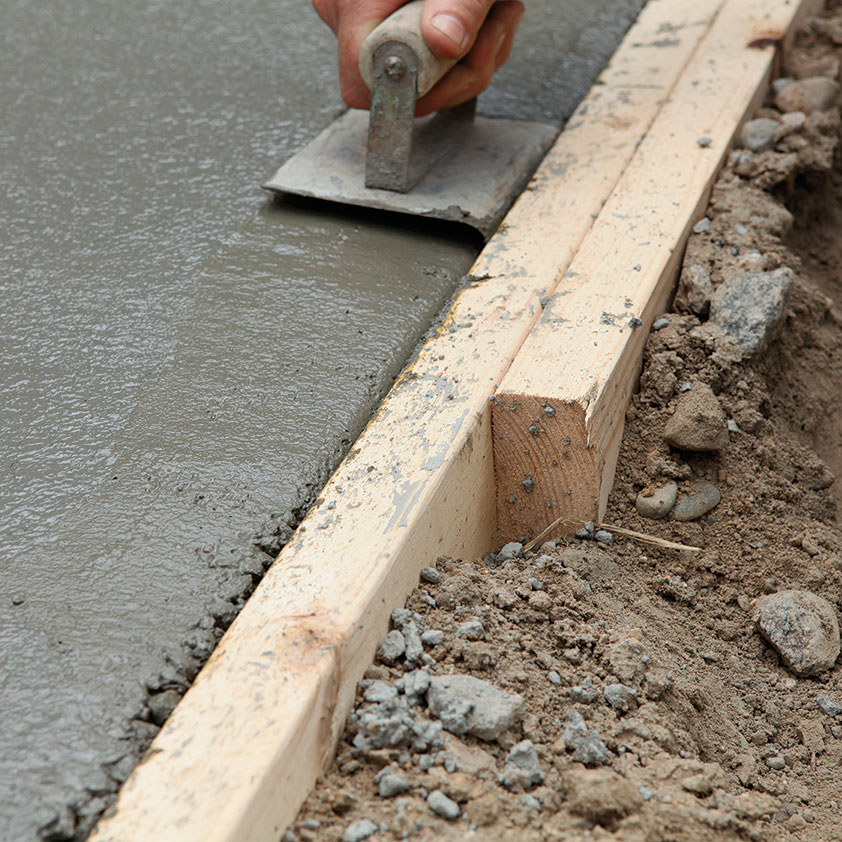 |
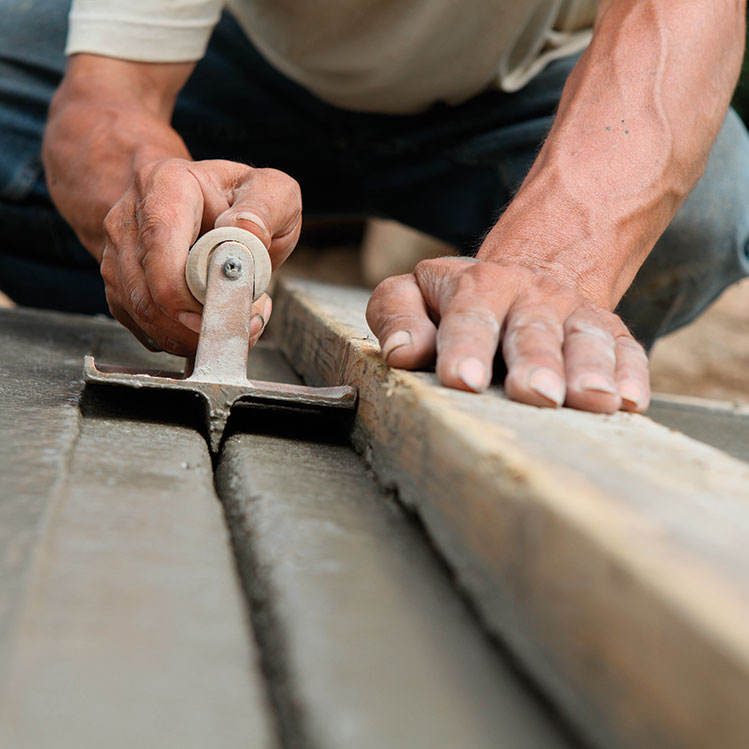 |
Edger and Groover
Edgers are small steel trowels that impart a radius edge to slabs. This edge is less prone to chipping and friendlier in use than a square one would be. I use edgers at two points during the finishing process. The first is shortly after bull-floating. At this point, the goals are to separate the wet concrete from the forms to minimize chipping when the forms are removed, and to push the coarse aggregate down to allow a smooth finish to be imparted later. The second time I edge is after steel-troweling or brooming to give the slab a smooth, finished edge.
A groover is like a two-sided edger, used to mold control joints and decorative joints into the slab. It works fine for sidewalks and broom-finished patios, but I prefer to saw-cut control joints in garage and interior slabs because I think it looks better.
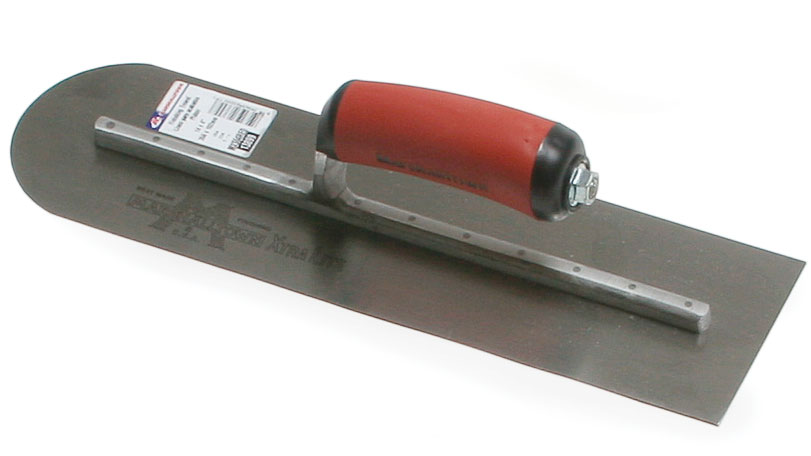
Steel trowel
The final tool used for a smooth slab, steel trowels are used after all the sheen from the bleed water is gone, but before the concrete is too stiff to work. A darby is a larger version of a steel trowel, with two handles. The trick to using a steel trowel is to keep the leading edge slightly elevated as you smooth the last remaining ridges and compact the surface. Pool trowels can be a useful finishing tool as well. Their rounded corners are less likely to leave ridges in the concrete.
Steel trowels should not be used on air-entrained concrete—these are finished with a mag trowel. Steel trowels close off the pores on the surface of the concrete, trapping in air that should be allowed to escape. Another common mistake is to sprinkle water on a slab that’s setting up too fast. Both of these things can lead to scaling and other surface failures. If it’s a hot day and it seems likely that the concrete will set faster than you can finish it, have the batch plant add retarder to the mix to buy extra time.
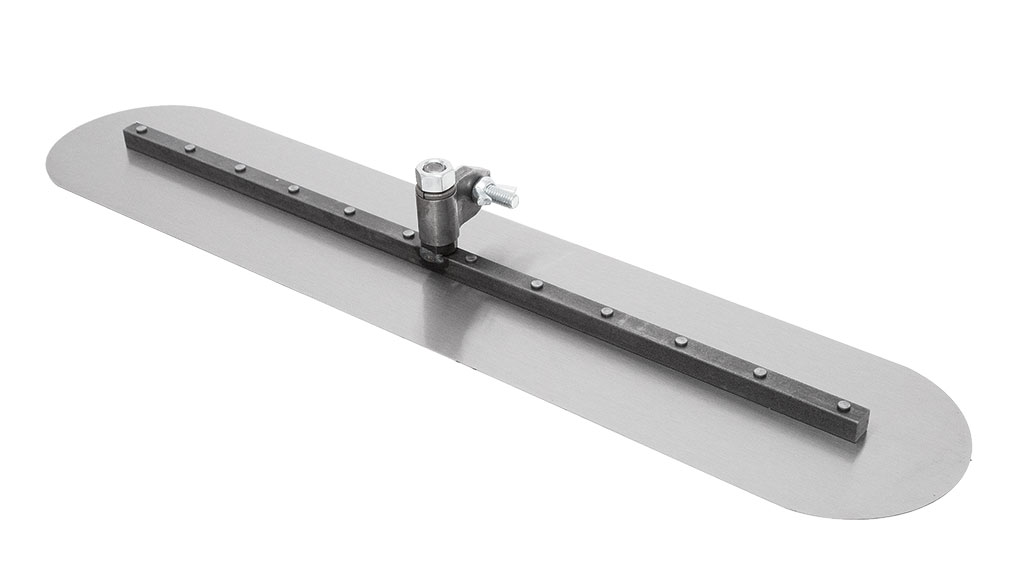
Fresno Trowel
Out West, concrete finishers routinely use Fresno trowels to finish concrete. Fresnos are larger than a handheld steel trowel and they attach to long handles like a bull float, making them ideal for large slabs. The downside is that because they’re larger than a hand trowel, they don’t compact the concrete surface as much, so the surface can end up less durable. Like smaller steel trowels, Fresnos should only be used after the concrete has been floated with a wood or mag float.
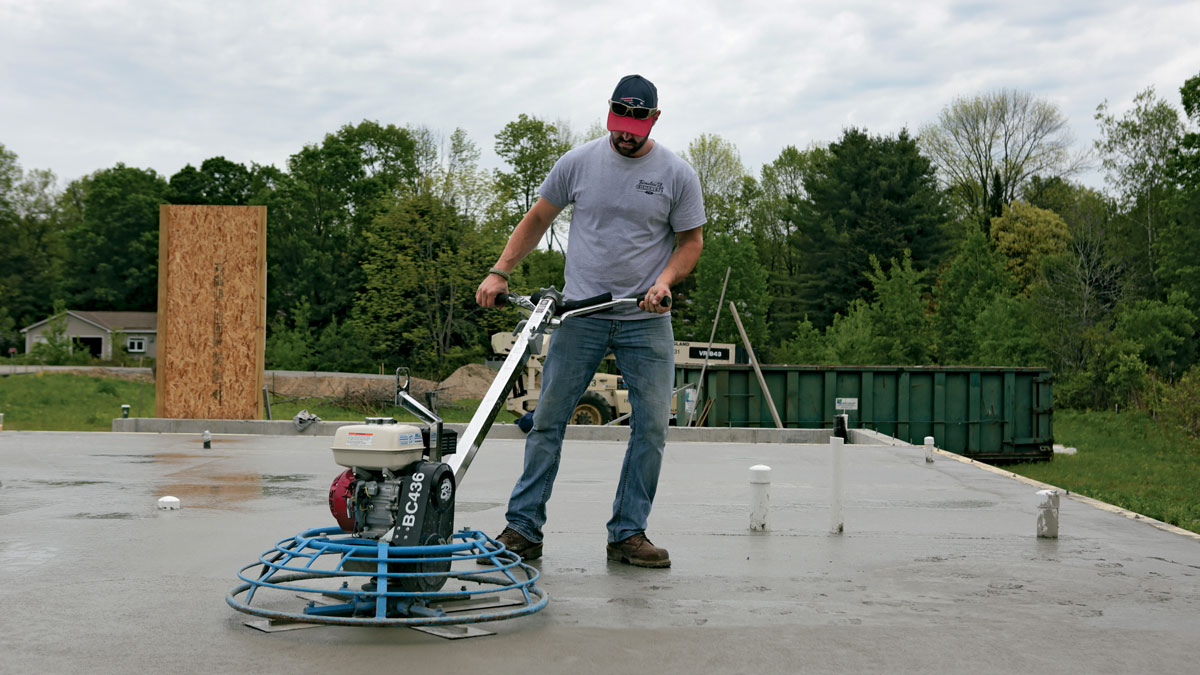
Power Trowel
I’ve never used one, but I regularly see professional finishers using a power trowel. It’s a great option for large slabs because its gas engine doesn’t get tired and it can cover more ground before the concrete is too hard to work. The secret to using this tool is to get it on the concrete at the right time. Start too early and it will sink into the fresh concrete, making a mess; wait too long and you won’t be able to smooth surface imperfections.
Power trowels can be equipped with float, finish, and combination blades. Talk to the rental company about what you’re trying to do and they can set up the machine for your project. The machine’s handle is how you control the direction of the power trowel: Lift up on the handle to move left; push down to go right.
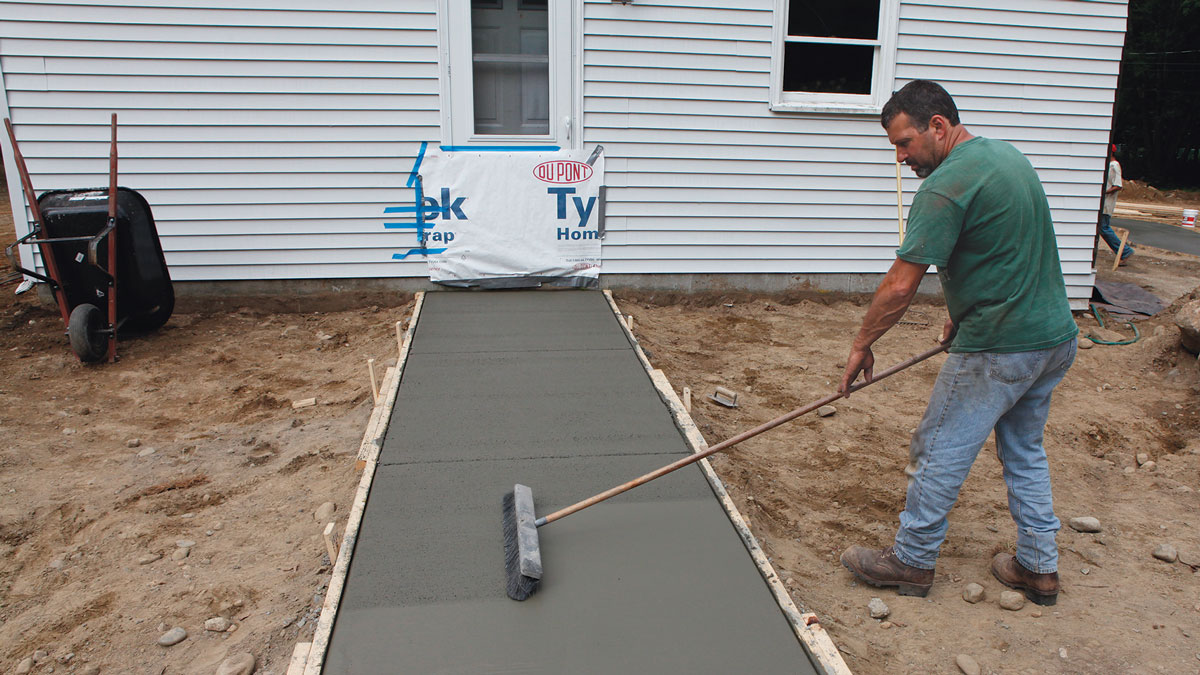
Concrete Broom
Sometimes you don’t want the polished surface steel trowels create on concrete. Usually this is because they can be slippery when wet. In these cases, a broom finish is called for. After mag-floating and while the concrete is still wet, a broom simply is dragged across the surface of the slab. Any broom can be used, but special concrete brooms are available with finer or coarser bristles depending on the finish desired. Brooms are also available that attach to a bull-float handle, extending the finisher’s reach so you don’t have to walk on the slab to broom it. Once the slab is broomed, an edger is used to finish the corners.
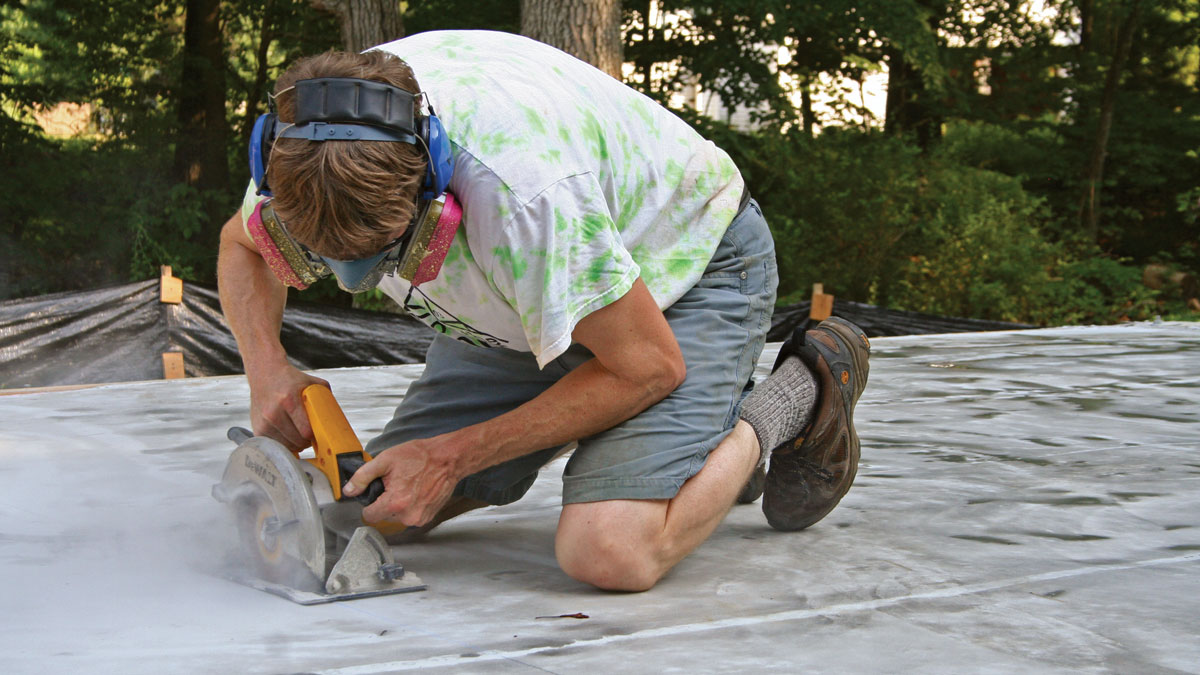 |
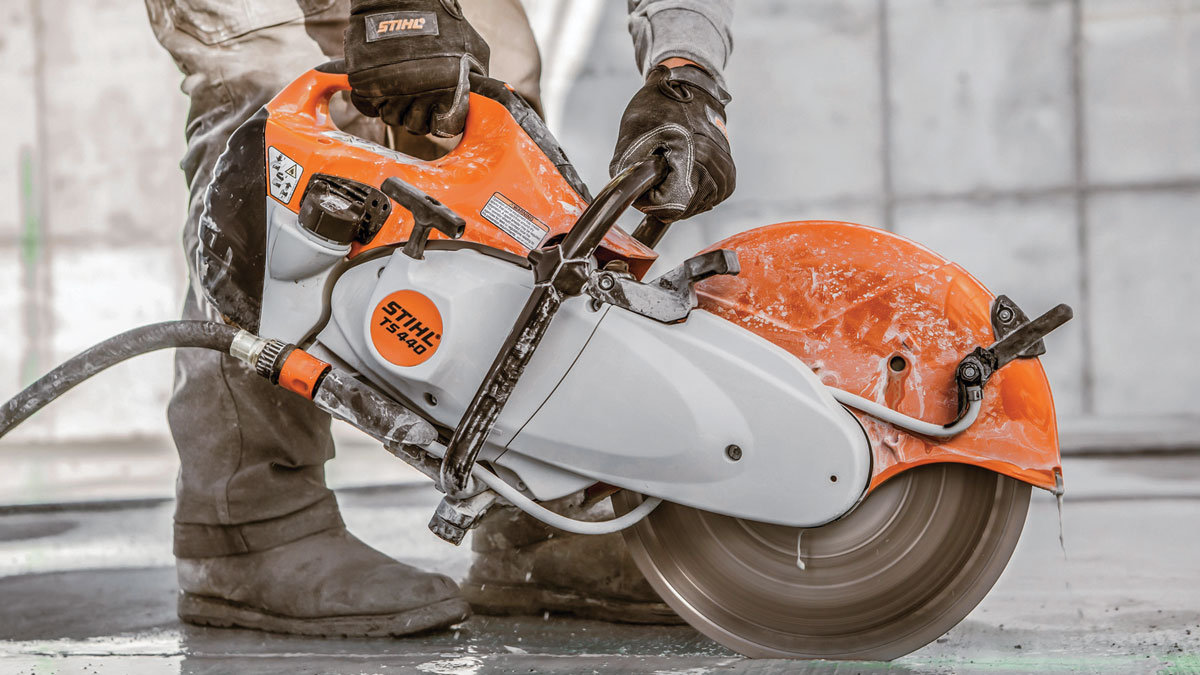 |
Concrete Saw
The old saying is that there are two kinds of concrete: Concrete that has cracked, and concrete that hasn’t cracked yet. Assuming everything else was done correctly, thermal expansion is the main cause of cracking. It’s essentially unavoidable.
The way to avoid cracks looking like defects is to saw-cut control joints a day or two after the pour. Saw cuts are straight and look deliberate, not like mistakes. Saw cuts should be one-quarter the depth of the slab, and the slab should be divided into rectangular sections that are as close to square as possible to even out the amount of movement between saw cuts. For residential purposes, 10-ft. squares are about right, although the size isn’t a hard-and-fast rule.
You can use a circular saw with an abrasive or diamond blade for small cuts (use this tip for wetting the surface to keep dust down), but even better is a gasoline-powered concrete saw, which is rentable. Also described as a cutoff machine or power cutter, a concrete saw is the preferred tool for bigger jobs, but only outdoors unless you have a carbon monoxide death wish.
– Former editor Andy Engel is a builder in Roxbury, Conn.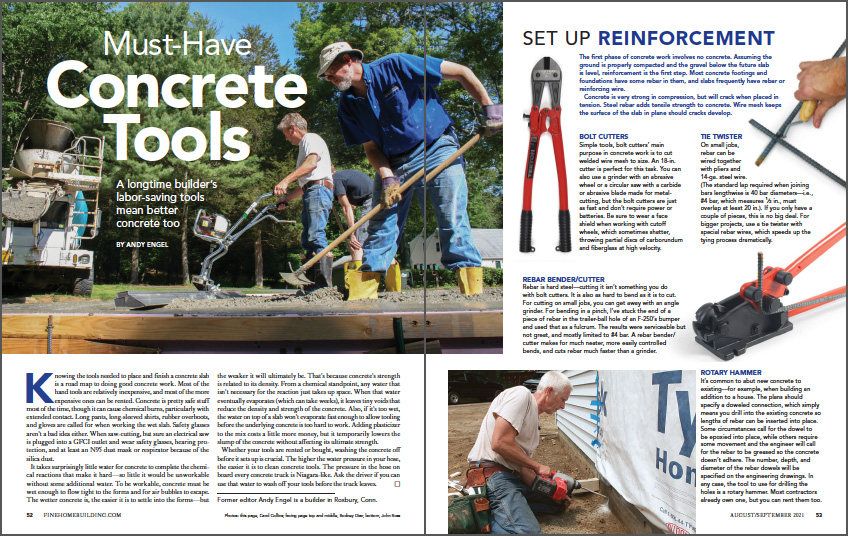
From Fine Homebuilding #301
To read the entire article, please click the View PDF button below.
RELATED LINKS





